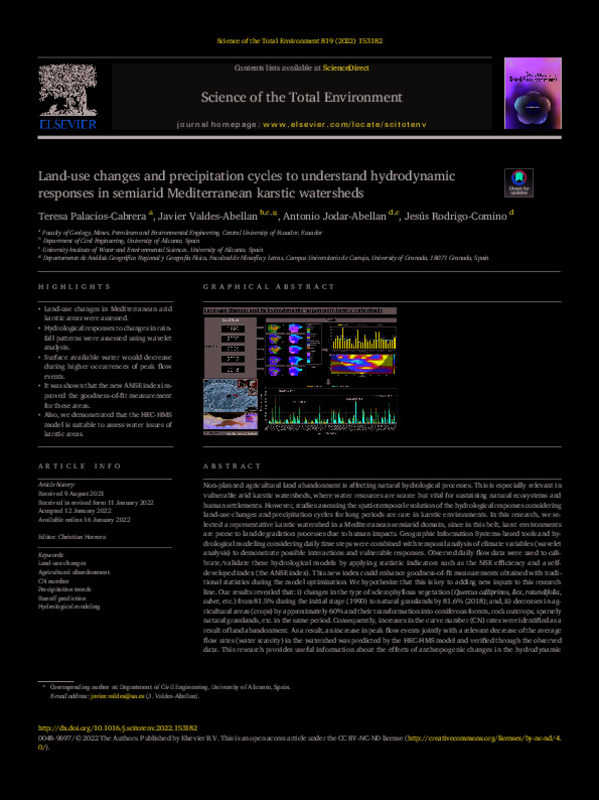JavaScript is disabled for your browser. Some features of this site may not work without it.
Buscar en RiuNet
Listar
Mi cuenta
Estadísticas
Ayuda RiuNet
Admin. UPV
Land-use changes and precipitation cycles to understand hydrodynamic responses in semiarid Mediterranean karstic watersheds
Mostrar el registro sencillo del ítem
Ficheros en el ítem
| dc.contributor.author | Palacios-Cabrera, Teresa
|
es_ES |
| dc.contributor.author | Valdés-Abellán, Javier
|
es_ES |
| dc.contributor.author | Jódar-Abellán, Antonio
|
es_ES |
| dc.contributor.author | Rodrigo-Comino, Jesús
|
es_ES |
| dc.date.accessioned | 2024-01-11T19:03:06Z | |
| dc.date.available | 2024-01-11T19:03:06Z | |
| dc.date.issued | 2022-05-01 | es_ES |
| dc.identifier.issn | 0048-9697 | es_ES |
| dc.identifier.uri | http://hdl.handle.net/10251/201839 | |
| dc.description.abstract | [EN] Non-planned agricultural land abandonment is affecting natural hydrological processes. This is especially relevant in vulnerable arid karstic watersheds, where water resources are scarce but vital for sustaining natural ecosystems and human settlements. However, studies assessing the spatiotemporal evolution of the hydrological responses considering land-use changes and precipitation cycles for long periods are rare in karstic environments. In this research, we selected a representative karstic watershed in a Mediterranean semiarid domain, since in this belt, karst environments are prone to land degradation processes due to human impacts. Geographic Information Systems-based tools and hydrological modeling considering daily time steps were combined with temporal analysis of climate variables (wavelet analysis) to demonstrate possible interactions and vulnerable responses. Observed daily flow data were used to calibrate/validate these hydrological models by applying statistic indicators such as the NSE efficiency and a self-developed index (the ANSE index). This new index could enhance goodness-of-fit measurements obtained with traditional statistics during the model optimization. We hypothesize that this is key to adding new inputs to this research line. Our results revealed that: i) changes in the type of sclerophyllous vegetation (Quercus calliprinos, ilex, rotundifolia, suber, etc.) from 81.5% during the initial stage (1990) to natural grasslands by 81.6% (2018); and, ii) decreases in agricultural areas (crops) by approximately 60% and their transformation into coniferous forests, rock outcrops, sparsely natural grasslands, etc. in the same period. Consequently, increases in the curve number (CN) rates were identified as a result of land abandonment. As a result, an increase in peak flow events jointly with a relevant decrease of the average flow rates (water scarcity) in the watershed was predicted by the HEC-HMS model and verified through the observed data. This research provides useful information about the effects of anthropogenic changes in the hydrodynamic behaviour of karstic watersheds and water resource impacts, especially key in water-scarce areas that depict important hazards for the water supply of related populations and natural ecosystems. | es_ES |
| dc.description.sponsorship | This research was funded partially by the Central University of Ecuador and by the projects RESERVOIR (PRIMA programme supported by the European Union under grant agreement no. 1924) and BBVA2021-Leonardo2 along with local companies (projects Comunidad Regantes 220-I and Comunidad Regantes 1-20T). Antonio Jodar-Abellan acknowledges financial support received from the project BBVA2021-Leonardo2. In the same way, this work has been conducted within the Catedra del Agua of the University of Alicante (catedradelaguaua.org). Moreover, authors acknowledge the reviewers of the manuscript whose comments contributed greatly to improve this paper. | es_ES |
| dc.language | Inglés | es_ES |
| dc.publisher | Elsevier | es_ES |
| dc.relation.ispartof | Science of The Total Environment | es_ES |
| dc.rights | Reconocimiento - No comercial - Sin obra derivada (by-nc-nd) | es_ES |
| dc.subject | Land-use changes | es_ES |
| dc.subject | Agricultural abandonment | es_ES |
| dc.subject | CN number | es_ES |
| dc.subject | Precipitation trends | es_ES |
| dc.subject | Runoff prediction | es_ES |
| dc.subject | Hydrological modeling | es_ES |
| dc.title | Land-use changes and precipitation cycles to understand hydrodynamic responses in semiarid Mediterranean karstic watersheds | es_ES |
| dc.type | Artículo | es_ES |
| dc.identifier.doi | 10.1016/j.scitotenv.2022.153182 | es_ES |
| dc.relation.projectID | info:eu-repo/grantAgreement/EC//1924//PRIMA Programme/ | es_ES |
| dc.relation.projectID | info:eu-repo/grantAgreement/fBBVA//BBVA2021- Leonardo2/ | es_ES |
| dc.relation.projectID | info:eu-repo/grantAgreement/UCE//RESERVOIR/ | es_ES |
| dc.rights.accessRights | Abierto | es_ES |
| dc.description.bibliographicCitation | Palacios-Cabrera, T.; Valdés-Abellán, J.; Jódar-Abellán, A.; Rodrigo-Comino, J. (2022). Land-use changes and precipitation cycles to understand hydrodynamic responses in semiarid Mediterranean karstic watersheds. Science of The Total Environment. 819:1-12. https://doi.org/10.1016/j.scitotenv.2022.153182 | es_ES |
| dc.description.accrualMethod | S | es_ES |
| dc.relation.publisherversion | https://doi.org/10.1016/j.scitotenv.2022.153182 | es_ES |
| dc.description.upvformatpinicio | 1 | es_ES |
| dc.description.upvformatpfin | 12 | es_ES |
| dc.type.version | info:eu-repo/semantics/publishedVersion | es_ES |
| dc.description.volume | 819 | es_ES |
| dc.identifier.pmid | 35045347 | es_ES |
| dc.relation.pasarela | S\460803 | es_ES |
| dc.contributor.funder | Fundación BBVA | es_ES |
| dc.contributor.funder | European Commission | es_ES |
| dc.contributor.funder | Universidad Central del Ecuador | es_ES |
| dc.subject.ods | 13.- Tomar medidas urgentes para combatir el cambio climático y sus efectos | es_ES |
| dc.subject.ods | 15.- Proteger, restaurar y promover la utilización sostenible de los ecosistemas terrestres, gestionar de manera sostenible los bosques, combatir la desertificación y detener y revertir la degradación de la tierra, y frenar la pérdida de diversidad biológica | es_ES |








